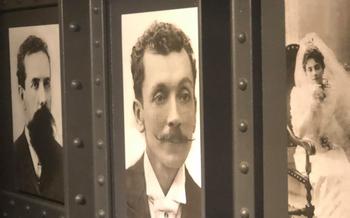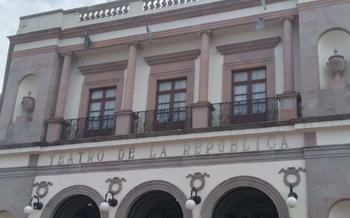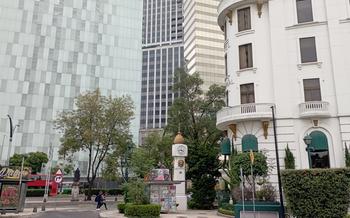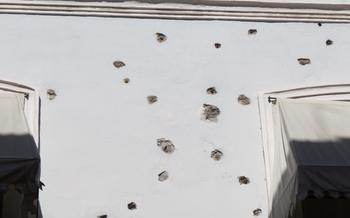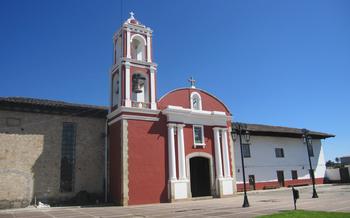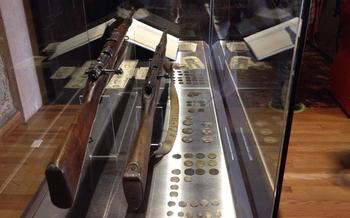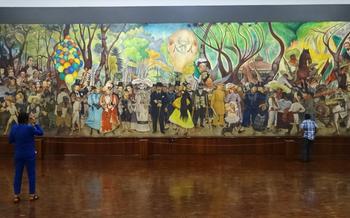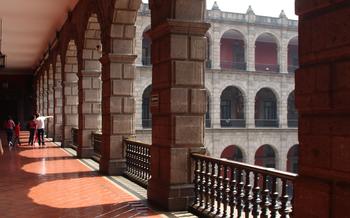
Museo de la Revolución Mexicana
- Museo de la Revolución Mexicana: Symbol of a Great Revolution
- Location and Architecture: A Journey Through Time
- Exhibitions and Collections: Uncovering the Revolution
- The Madero Hall: A Tribute to a President
- The Villa and Zapata Hall: Revolutionary Icons
- The Constitutionalist Movement: Shaping the Republic
- The Northern Front: A Battle for Sovereignty
- The Southern Front: Zapata's Revolutionary Stronghold
- The Cultural Revolution: Art and Expression
- Interactive Displays: A Dynamic Experience
- Educational Programs: Nurturing Young Minds
- Temporary Exhibitions: Exploring Diverse Perspectives
- Museum Shop: A Treasure Trove of Revolutionary Memorabilia
- Photography and Filming: Capturing Revolutionary Moments
- Insider Tip: Guided Tours for a Deeper Dive
Museo de la Revolución Mexicana: Symbol of a Great Revolution
The Museo de the Mexican Revolution, a pivotal event that reshaped the nation's political, social, and cultural landscape. Established in 1980, the museum serves as a tribute to the revolutionary struggle and its significant figures, aiming to create awareness about the relevance of this national movement and its enduring legacy. Through captivating exhibits, immersive displays, and educational programs, the museum invites visitors on a journey through the tumultuous years of revolution, shedding light on the events, ideals, and individuals that shaped Mexico's destiny.
Location and Architecture: A Journey Through Time
The Museo de la Revolución Mexicana resides at Calle Hidalgo 603, Colonia Centro, Zacatecas, Zacatecas 98000, Mexico. To reach this historical site, visitors can embark on a scenic walk through the captivating streets of Zacatecas' historic center, a UNESCO World Heritage Site.
The architectural design of the museum is a remarkable fusion of neoclassical and colonial styles, paying homage to the building's rich history. Originally constructed in the 18th century as the Colegio de San Luis Gonzaga, the building served as an educational institution for over a century. Its transformation into the Museo de la Revolución Mexicana in 1984 breathed new life into its walls, preserving the legacy of the revolutionary struggle.
The neoclassical facade of the museum features elegant arches and intricate carvings, while the interior boasts spacious galleries and courtyards that house the museum's extensive collection. The harmonious blend of architectural styles creates a captivating ambiance that transports visitors back in time, immersing them in the history of the Mexican Revolution.
Exhibitions and Collections: Uncovering the Revolution
The Museo de la Revolución Mexicana showcases an extensive collection of artifacts, documents, and historical relics that offer visitors a comprehensive insight into the Mexican Revolution. The permanent exhibition is divided into several sections, each focusing on a specific aspect of the revolutionary struggle.
One section is dedicated to the origins of the revolution, showcasing documents and artifacts that shed light on the social, economic, and political conditions that led to the uprising. Visitors can learn about the grievances of the Mexican people and the reasons why they took up arms against the oppressive regime of Porfirio Díaz.
Another section focuses on the military campaigns and battles of the revolution. Here, visitors can see displays of weapons, uniforms, and other military equipment used by the revolutionary forces. They can also learn about the strategies and tactics employed by the different factions in the conflict.
The museum also features interactive multimedia presentations that bring the revolution to life. Visitors can watch short films, listen to audio recordings, and interact with touchscreens to learn more about the key events and figures of the revolution.
In addition to the permanent exhibition, the museum also hosts temporary exhibits that explore different aspects of the revolution and its impact on Mexican society. These exhibits often feature artifacts and documents that have never been seen before by the public.
The Madero Hall: A Tribute to a President
Francisco I. Madero, a visionary leader and revolutionary, played a pivotal role in igniting the spark of the Mexican Revolution. The Madero Hall within the Museo de la Revolución Mexicana stands as a testament to his life, presidency, and the tragic events that unfolded during his time.
Exhibits in this section showcase Madero's humble beginnings, his rise to prominence as a political reformer, and his eventual election as president in 19Visitors can delve into the ideals and principles that drove Madero's vision for a more just and democratic Mexico.
Among the highlights of the Madero Hall are personal artifacts, documents, and speeches that provide insights into his character and leadership style. The hall also commemorates the tragic events of the Decena Trágica (Ten Tragic Days) in 1913, which led to Madero's overthrow and assassination.
Madero's legacy extends far beyond his presidency. His unwavering belief in democracy and social justice continues to inspire generations of Mexicans. The Madero Hall serves as a poignant reminder of the sacrifices made by those who fought for a better Mexico and the enduring impact of Madero's ideals on the nation's history.
The Villa and Zapata Hall: Revolutionary Icons
Pancho Villa and Emiliano Zapata, two legendary figures of the Mexican Revolution, are celebrated in this hall dedicated to their remarkable lives and contributions. Through captivating exhibits and historical artifacts, visitors can delve into the stories of these revolutionary icons.
Villa's military prowess and charisma are vividly portrayed, showcasing his leadership of the División del Norte and his strategic victories. Interactive displays allow visitors to explore the intricacies of Villa's military strategies and his impact on the course of the revolution.
Zapata's unwavering commitment to land reform is highlighted through the Plan de Ayala, a document that articulated the demands of the peasant class. The hall showcases the role of Zapata's peasant army, known as the Zapatistas, and their tireless fight for social justice and land redistribution.
The legacies of Villa and Zapata extend beyond their military achievements. Their ideals and principles continue to resonate in Mexican society, shaping the country's political landscape and social fabric. This hall honors their enduring influence and reminds visitors of the profound impact they had on Mexico's history.
The Constitutionalist Movement: Shaping the Republic
The Constitutionalist Movement emerged as a response to the dictatorial rule of Victoriano Huerta, who seized power in 1913 after the assassination of President Francisco I. Madero. Led by Venustiano Carranza, the movement sought to restore constitutional order and establish a democratic government in Mexico.
The Constitutionalists gained momentum and support from various factions, including the remnants of Madero's followers, liberal politicians, and disaffected military officers. Carranza's leadership and diplomatic skills played a crucial role in uniting these diverse groups under a common cause.
The 1917 Constitution, drafted and promulgated by the Constitutionalist government, stands as a testament to their commitment to social and political transformation. The constitution introduced groundbreaking provisions, including the right to vote for women, land reform measures, labor rights, and the separation of church and state.
The Constitutionalist Movement's victory in 1917 marked a watershed moment in Mexican history. The new constitution laid the foundation for a more democratic and just society, addressing long-standing issues of inequality and social injustice. Carranza's presidency ushered in a period of reconstruction and reform, shaping the political landscape of Mexico for decades to come.
The Northern Front: A Battle for Sovereignty
The Northern Front played a pivotal role in the Mexican Revolution, serving as a strategic battleground for revolutionary forces led by Francisco Villa and his División del Norte. The region's proximity to the United States made it a crucial gateway for arms and supplies, fueling the revolutionary struggle. Villa's military prowess and his ability to mobilize peasant armies proved instrumental in securing victories against the federal forces.
The Northern Front was characterized by intense fighting and shifting alliances. Villa's División del Norte clashed with both federal troops and rival revolutionary factions, demonstrating the complex and fluid nature of the revolutionary conflict. The region's rugged terrain and harsh climate added to the challenges faced by the revolutionary forces, testing their endurance and resilience.
Despite the challenges, the Northern Front remained a key stronghold for Villa and his followers. Their victories in battles such as Torreón and Zacatecas cemented their reputation as formidable fighters and contributed to the growing momentum of the revolutionary movement. The Northern Front's strategic importance and Villa's leadership played a crucial role in shaping the course of the Mexican Revolution.
The Southern Front: Zapata's Revolutionary Stronghold
In the heart of southern Mexico, Emiliano Zapata emerged as a powerful symbol of resistance and agrarian reform during the Mexican Revolution. The Southern Front, under Zapata's leadership, became a crucial battleground in the fight for land rights and social justice.
The Plan de Ayala, a revolutionary manifesto drafted by Zapata and his followers, outlined their demands for land redistribution, an end to haciendas, and the improvement of peasants' living conditions. This document served as a rallying cry for the marginalized peasantry, who flocked to Zapata's banner in droves.
Zapata's peasant army, known as the Liberation Army of the South, employed guerrilla tactics and a deep understanding of the terrain to challenge the federal forces and hacienda owners. Their victories in key battles, such as the taking of Cuautla, demonstrated the strength and determination of the Southern Front.
The legacy of the Southern Front extends beyond the battlefield. Zapata's ideals of land reform and social equality left an indelible mark on Mexican society. His struggle for justice and dignity continues to inspire movements fighting for the rights of the marginalized and dispossessed.
The Museo de la Revolución Mexicana pays homage to Zapata's contributions through exhibits that showcase his personal effects, military strategies, and the impact of his revolutionary movement. Visitors can gain a deeper understanding of Zapata's vision for a more just and equitable Mexico.
The Cultural Revolution: Art and Expression
The Mexican Revolution not only brought about political and social changes but also had a profound impact on the cultural landscape of the country. The revolutionary period witnessed an explosion of artistic expression and creativity, as artists and intellectuals sought to capture the essence of the struggle and its aftermath.
The most notable manifestation of this cultural revolution was the rise of muralism, a movement that used large-scale murals to depict historical events, social issues, and revolutionary ideals. Renowned muralists such as Diego Rivera, José Clemente Orozco, and David Alfaro Siqueiros created powerful and iconic murals that adorned the walls of public buildings and institutions, transforming them into canvases of revolutionary history.
Their works reflected the spirit of the revolution, celebrating the struggle for social justice, land reform, and national identity. The murals became a powerful tool for educating the masses and raising awareness about the social and political issues of the time. They also served as a means of preserving the memory of the revolution and its heroes, immortalizing their stories and sacrifices for future generations.
The cultural revolution extended beyond muralism, influencing various other art forms such as literature, music, and theater. Writers and poets used their pens to chronicle the events of the revolution and explore its social and psychological impact. Composers and musicians created corridos, a traditional form of Mexican folk music, that celebrated the exploits of revolutionary leaders and the struggles of the people.
Theatrical productions and performances also played a significant role in promoting revolutionary ideals and raising awareness about social issues. These artistic expressions collectively contributed to the shaping of a new Mexican cultural identity, one that was rooted in the revolutionary struggle and its aspirations for a more just and equitable society.
Interactive Displays: A Dynamic Experience
The Museo de la Revolución Mexicana embraces technology to enhance the visitor experience through interactive displays. These engaging exhibits bring history to life, allowing visitors to engage with the content in a dynamic and memorable way. Virtual reality experiences transport visitors to the battlefields of the revolution, while touch screens and interactive maps provide in-depth information about key events and figures. Multimedia presentations showcase historical footage, interviews, and reenactments, offering a multisensory journey through the revolutionary era. These interactive elements not only educate and entertain but also cater to different learning styles, ensuring that visitors of all ages can connect with the museum's content.
Educational Programs: Nurturing Young Minds
The Museo de la Revolución Mexicana recognizes the importance of fostering historical awareness and critical thinking in young minds. To achieve this, the museum offers an array of educational programs tailored to students and groups of all ages. Engaging workshops, lectures, and guided tours provide participants with an immersive and interactive learning experience.
These programs are carefully designed to delve into the intricacies of the Mexican Revolution, shedding light on its causes, events, and consequences. Through interactive activities and discussions, students explore the motivations and challenges faced by the revolutionary leaders, while also gaining insights into the social, political, and economic transformations that shaped Mexico during this tumultuous period.
By promoting historical awareness and encouraging critical thinking, the Museo de la Revolución Mexicana plays a vital role in preserving and transmitting the legacy of this transformative event to future generations. These educational initiatives empower young learners to become informed and engaged citizens, fostering a deeper understanding of their nation's past and its impact on the present.
Temporary Exhibitions: Exploring Diverse Perspectives
The Museo de la Revolución Mexicana not only houses a permanent exhibition but also hosts a variety of temporary exhibitions that offer diverse perspectives on the revolution and its impact. These exhibitions delve into specific themes, events, or figures related to the revolutionary era, providing visitors with a deeper understanding of the complexities of this transformative period.
Recent temporary exhibitions have explored topics such as the role of women in the revolution, the impact of the revolution on indigenous communities, and the artistic and cultural expressions that emerged during this tumultuous time. These exhibitions often feature unique artifacts, documents, and multimedia presentations that bring the past to life and offer fresh insights into the Mexican Revolution.
By presenting diverse perspectives, the temporary exhibitions at the Museo de la Revolución Mexicana contribute to a more comprehensive understanding of this pivotal event in Mexican history. They challenge traditional narratives and encourage visitors to consider the revolution from different angles, fostering a more nuanced appreciation of its complexities and consequences.
These temporary exhibitions also add a dynamic element to the museum's offerings, ensuring that visitors have a fresh and engaging experience with each visit. They provide an opportunity to explore new aspects of the revolution, learn about ongoing research, and engage with contemporary interpretations of this defining moment in Mexico's history.
Museum Shop: A Treasure Trove of Revolutionary Memorabilia
The Museo de la Revolución Mexicana also boasts a well-stocked museum shop, offering a diverse selection of souvenirs, books, and historical items related to the revolution. Visitors can delve into a treasure trove of unique and meaningful items that serve as lasting mementos of their visit.
From intricately designed replicas of revolutionary artifacts to commemorative posters and postcards, the museum shop provides a wide range of souvenirs to suit every taste and budget. Visitors can also purchase books that delve into the history of the revolution, written by renowned authors and historians. These books offer in-depth insights into the events and personalities that shaped this pivotal period in Mexico's history.
Supporting the museum through its shop is a meaningful way for visitors to contribute to the preservation and promotion of revolutionary history. Every purchase directly supports the museum's ongoing efforts to collect, preserve, and share the stories of the Mexican Revolution.
Whether seeking a unique souvenir or a thought-provoking book, the museum shop is a must-visit for those who want to delve deeper into the history and legacy of the Mexican Revolution.
Photography and Filming: Capturing Revolutionary Moments
The Museo de la Revolución Mexicana encourages visitors to capture their experiences through photography and filming, allowing them to create lasting memories and share their insights with others. However, it is essential to adhere to the museum's guidelines to ensure the preservation and respect of its exhibits.
Photography and filming are permitted within the museum, but the use of flash is prohibited to prevent damage to the artifacts and artworks. Visitors are encouraged to use natural light or low-light settings to capture the essence of the exhibits without compromising their integrity.
Tripods and other photography equipment are allowed, but they must be used responsibly and without obstructing the paths of other visitors. The museum staff is always willing to assist with any questions or concerns regarding photography and filming within the premises.
By following these guidelines, visitors can not only capture their revolutionary moments but also contribute to the preservation and promotion of this important historical institution. Sharing their experiences through social media platforms can help spread awareness about the museum and its mission, inspiring others to embark on a journey through the history of the Mexican Revolution.
Insider Tip: Guided Tours for a Deeper Dive
To fully immerse yourself in the captivating narratives of the Mexican Revolution, consider booking a guided tour of the Museo de la Revolución Mexicana. These tours offer a deeper and more personalized exploration of the museum's exhibits and collections. Knowledgeable and passionate guides will lead you through the halls, providing insightful commentary and anecdotes that bring the revolutionary era to life.
Booking a guided tour is easy. Simply approach the museum's information desk or visit their website to inquire about availability and make a reservation. Various tour options are available, catering to different interests and schedules. Whether you're a history buff, a casual visitor, or traveling with a group, there's a tour tailored to suit your needs.
During my visit to the museum, I had the privilege of joining a guided tour led by a historian specializing in the Mexican Revolution. His in-depth knowledge and enthusiasm for the subject were contagious, making the tour an unforgettable experience. He shared fascinating stories and pointed out details that I would have missed if exploring the museum independently.
I highly recommend booking a guided tour to enhance your visit to the Museo de la Revolución Mexicana. It's an investment that will reward you with a deeper understanding of this pivotal period in Mexican history and leave you with lasting memories.
